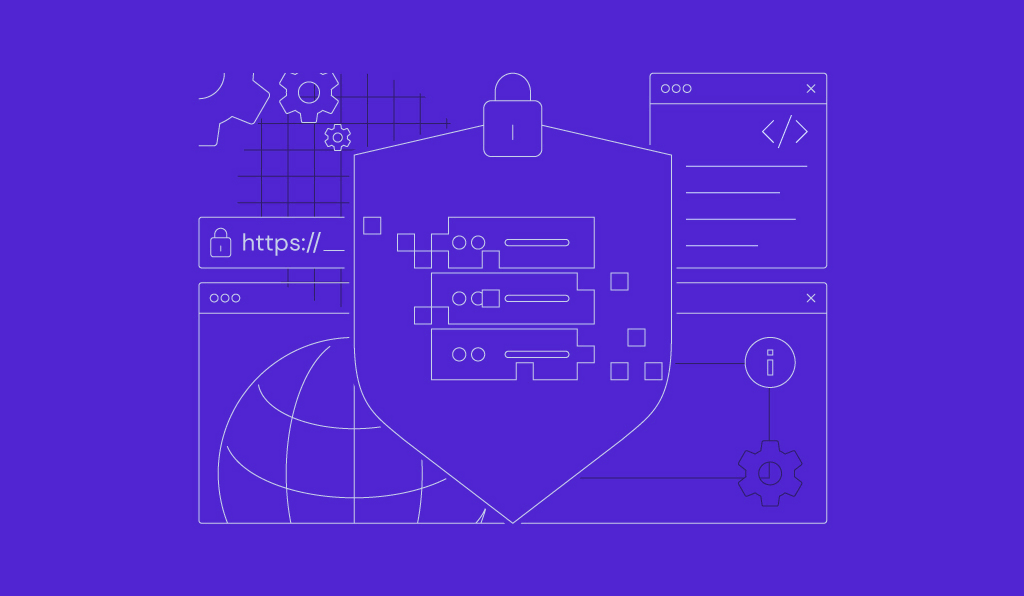9 best Heroku alternatives: Cost-effective, scalable options for developers
Heroku has long been a popular platform-as-a-service (PaaS) for developers due to its simplicity, ease of use, and robust ecosystem of add-ons. However, with the recent changes, including the discontinuation of the free tier and the limited customization options, many developers are seeking alternatives.
Whether you’re looking for more control over your infrastructure, cost-effective solutions, or greater scalability, there are plenty of Heroku alternatives that can better meet your needs.
In this article, we’ll explore the top 9 Heroku alternatives, each offering unique features, pricing models, and use cases. From self-hosted solutions like Coolify and Dokku to fully-managed platforms like Render and Fly.io, we’ll help you find the right platform for your next project.
We’ll also highlight key factors to consider when choosing the best alternative for your requirements, whether you’re building small personal apps or large-scale web applications.
Why consider a Heroku alternative?
Although Heroku remains a popular platform-as-a-service (PaaS), several factors may prompt you to explore alternatives. Whether you’re seeking better control, cost savings, or scalability, understanding the limitations of Heroku can help you make an informed decision. Here are some key reasons why you might want to consider a Heroku alternative:
- Sleep mode. Heroku’s Eco plan, their most basic option, puts web and worker dynos to sleep after 30 minutes of inactivity. While this helps conserve dyno hours, sleeping dynos take a few seconds to restart when traffic returns, which can cause delays for apps that need to be instantly responsive.
- Pricing spikes. Their Eco plan is affordable at $5/month for light usage, but this can grow fast as you scale. Adding dynos, workers, or services can push monthly bills higher than expected, making it less ideal for resource-heavy or unpredictable workloads.
- Resource constraints. Heroku dynos have limited memory and CPU resources, both predefined by dyno type. Unlike other platforms, you can’t manually adjust these resources – you can only change them by switching tiers, which makes scaling less precise and potentially inefficient.
- Not ideal for larger businesses. Heroku doesn’t offer a static outbound IP address by default, which can complicate integrations that require IP whitelisting. Static IPs are only available through paid add-ons or enterprise plans, adding cost and complexity.
- Reliability concerns. Heroku experienced a widespread service disruption on June 10, 2025, where many customers faced up to 24 hours of downtime after an unintended infrastructure update. These types of outages, combined with a history of similar incidents, have raised questions about the platform’s long-term reliability.
1. Coolify
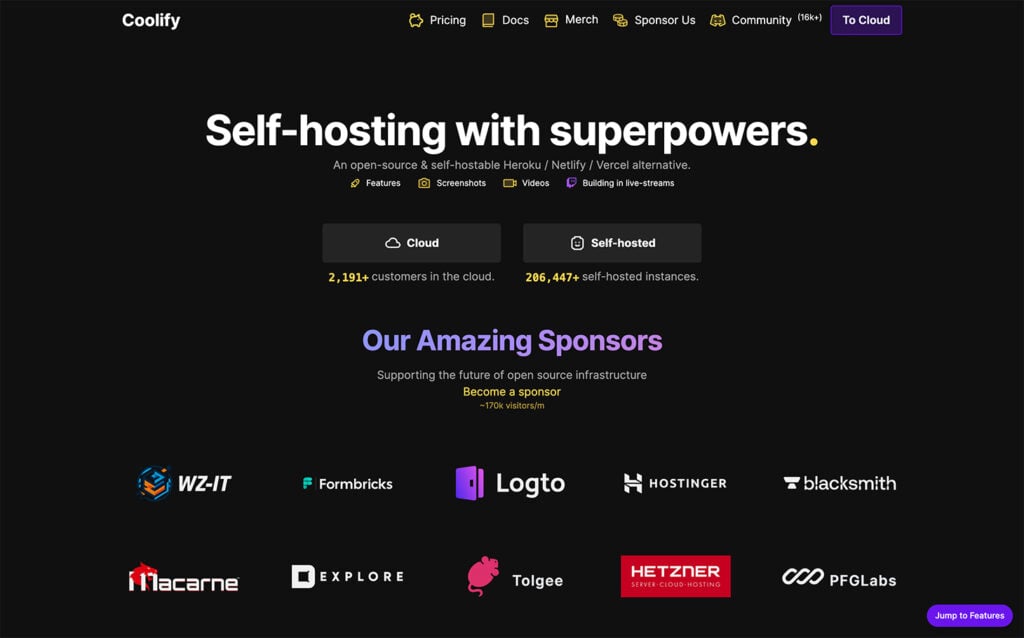
Coolify is a self-hosted Heroku alternative that’s open-source and supports Git-based deployment with Docker integration. This gives you full control over data, infrastructure, and resource limits.
With no vendor lock-in, Coolify is ideal for developers who want Heroku’s simplicity without platform constraints or ongoing fees.
Best for: Deploying web applications with a self-hosted platform that supports Git integration and full infrastructure control.
Pricing: Free if self-hosted. $5/month base price via Coolify Cloud for up to two connected servers, plus $3/month for each additional server.
Key features:
- Automated database backups to S3-compatible storage. Schedule regular backups and restore them easily – no extra plugins or manual work needed.
- Real-time terminal access via browser. Run server commands or fix issues directly from your browser without opening a separate SSH client.
- Team collaboration with role-based permissions. Invite team members and assign granular access controls for logs, deployments, and terminals.
- REST API for deployment and resource management. Automate infrastructure tasks or integrate with your workflows using Coolify’s robust API.
- One-click deployment for Docker-based services. Quickly spin up popular databases, backend services, or tools using Coolify’s prebuilt templates with minimal manual setup.
Pros:
- Free and open-source.
- Git-based deployments with pull request previews and automation.
- Full control and privacy through self-hosting and no vendor lock-in.
- Built-in monitoring, automated backups, and SSL management.
Cons:
- Requires you to set up and manage your own server.
- Steeper learning curve compared to fully managed platforms.
2. Dokploy

If you like what Coolify offers but want something more Docker-native, Dokploy is a strong alternative.
It’s an open-source control panel built for managing Docker-based applications, with support for tools like Docker Compose and Docker Swarm.
You can install Dokploy on any server, whether it’s a VPS or a lightweight device like a Raspberry Pi.
A VPS is often the most practical option for developers who want root access, predictable costs, and reliable performance.
If you’re exploring VPS providers, Hostinger offers a compelling choice with plans starting at $4.99/month.
Hostinger features NVMe SSD storage, dedicated IPs, full root access, and an intuitive dashboard that makes server management more accessible.
Hostinger pairs well with Dokploy for a flexible deployment stack without the typical restrictions of fully hosted platforms.
Best for: Building containerized apps with a self-hosted, Docker-native deployment platform that offers centralized server management.
Pricing: Free if self-hosted. Managed hosting starts at $4.50 per month.
Key features:
- Flexible deployment options. Choose between Nixpacks, Heroku Buildpacks, or custom Dockerfiles to match your app’s architecture.
- Zero-config remote server deployment. Deploy to multiple remote servers without manual configuration or scripting.
- Granular user access control. Manage team permissions with detailed roles to maintain secure operations.
- Built-in API and CLI tools. Extend Dokploy’s functionality or integrate it into your workflows through its developer-friendly interfaces.
- Prebuilt deployment templates. Quickly launch popular tools like Supabase, Pocketbase, or Cal.com using ready-to-use configurations.
Pros:
- Free and open-source.
- No programming language restriction.
- Easy database setup and backup support.
- Real-time monitoring dashboard.
Cons:
- Server setup required.
- Relatively new platform with a smaller community and limited documentation compared to more established tools.
- Supports Dockerized applications only.

3. Render

Render is a fully-managed PaaS that lets developers deploy APIs, applications, and static sites.
Unlike Heroku, Render includes persistent storage and offers a free tier, making it a more flexible choice for personal projects or early-stage apps.
Best for: Running apps on a fully managed cloud platform without the pricing and flexibility issues of Heroku.
Pricing: Free tier available for hobby projects and small-scale apps. Paid plans start at $19 per user/month, with additional compute costs based on usage.
Key features:
- Automatic Git-based deploys. Push to your connected repository and your app updates with zero downtime – no manual steps needed.
- Native support for multiple languages and Docker. Run Node.js, Python, Ruby, and other environments natively or use custom Docker images for added flexibility.
- Private networking across services. Secure internal communication between your apps without exposing traffic to the public internet.
- Infrastructure as code with Blueprints. Define your full stack in code and replicate environments consistently using Render’s Blueprint file.
- Isolated preview environments. Test pull requests in fully functional, temporary environments before going live.
Pros:
- Free tier for small apps, with flexible, usage-based pricing for scaling.
- Supports static sites, web services, background workers, and cron jobs.
- Offers advanced DDoS protection and persistent storage.
Cons:
- Not self-hostable.
- Less customizable infrastructure compared to raw cloud services.
4. Railway

Railway is a cloud-based deployment platform that simplifies setting up infrastructure and hosting applications. It lets developers quickly create services like databases, connect them to apps, and deploy code using Git or Docker.
Building on Heroku’s ease, Railway adds faster, reproducible builds with Nixpacks, pay-as-you-go pricing, PR deploys, and local development workflows.
Best for: Rapidly building and deploying web apps, APIs, or bots with built-in support for databases and seamless Git-based workflows.
Pricing: Free trial with $5 credit. Paid plans start at $5/month, with extra charges for additional usage.
Key features:
- Built-in database support. Set up and manage PostgreSQL, Redis, and other databases directly from your dashboard.
- Prebuilt templates. Launch apps, APIs, or bots quickly using Railway’s ready-to-use project templates.
- Autoscaling resources. Your app scales up or down based on usage, without manual intervention.
- Real-time monitoring. View live logs and performance metrics to stay on top of your app’s health.
- Preview environments for testing. Spin up separate environments for pull requests or feature branches.
- Infrastructure as code. Define your full app setup in a config file to replicate environments consistently.
Pros:
- Supports both source code and container-based deployments.
- Built-in support for databases, cron jobs, and environment variables.
- Clean developer dashboard with real-time logs and metrics.
- Git integration and automatic TLS certificate management.
Cons:
- Free tier offers limited usage and quickly requires upgrading for continuous or production-level projects.
- Relies on credits for uptime.
5. Fly.io
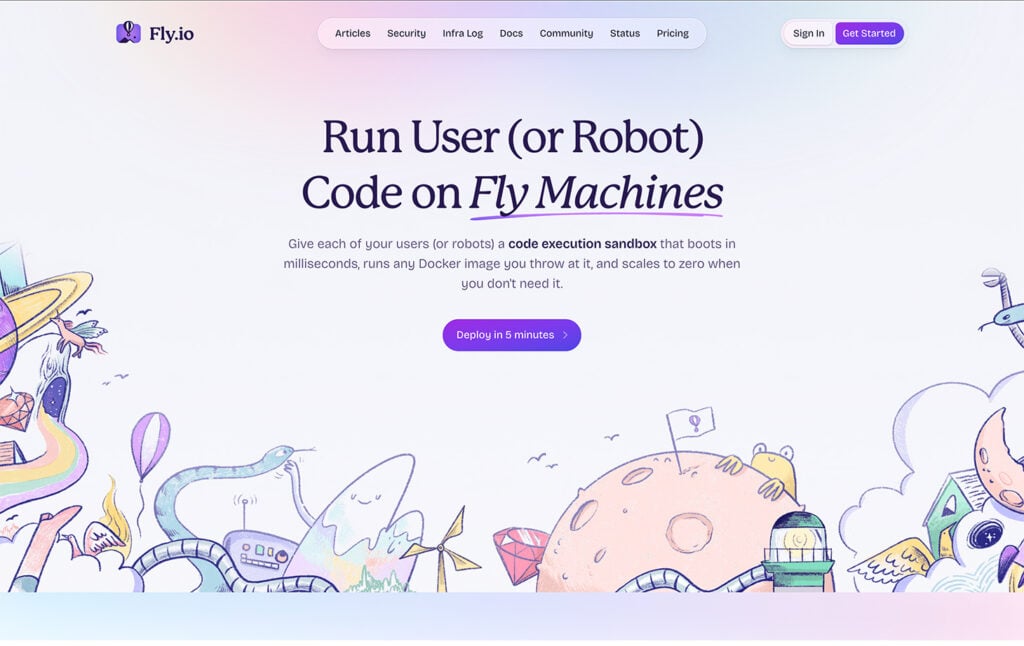
Fly.io is a modern PaaS designed to run your applications as close to end users as possible.
It deploys lightweight virtual machines in data centers around the world, reducing latency and improving performance.
Fly.io offers a Heroku-like developer experience but removes platform restrictions by giving you more control over where and how your app runs.
Best for: Building low-latency, globally distributed apps, such as real-time services or microservices, that require fine-grained infrastructure control and edge deployments.
Pricing: Primarily uses a flexible, usage-based model with no fixed tiers. Final costs depend entirely on your selected resources and can be estimated with Fly.io’s built-in pricing calculator.
Key features:
- Micro-VM deployment with sub-second startup. Launch apps using lightweight virtual machines that start almost instantly for fast global responses.
- Per-request routing through Fly Proxy. Route individual requests intelligently across instances to improve responsiveness and reduce load.
- Zero-downtime autoscaling. Scale your applications automatically based on demand, without affecting uptime or performance.
- Managed Postgres and object storage templates. Quickly spin up production-ready databases and object storage using prebuilt app templates.
Pros:
- Deploys apps closer to users using global edge locations.
- Supports Docker images and Heroku-style buildpacks.
- Built-in load balancing, health checks, and SSL.
- Persistent storage via Fly Volumes.
Cons:
- Has a learning curve for users unfamiliar with CLI tools and infrastructure management.
- Pricing can increase quickly with regional scaling.
- Smaller ecosystem and fewer prebuilt integrations compared to other established platforms.
- Pricing is usage-based with fewer predefined plans, which may make forecasting harder for some teams.
6. Dokku
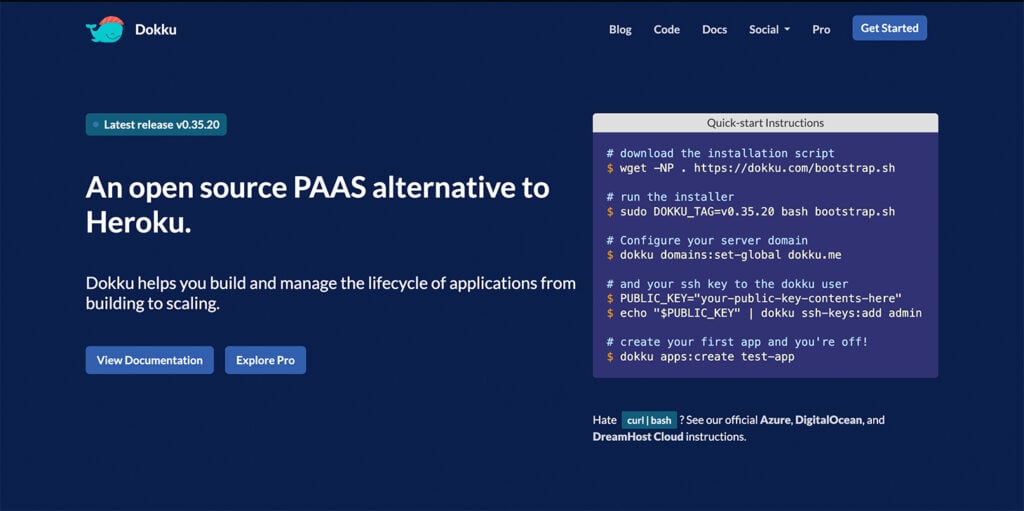
A self-hosted Heroku alternative that’s open source, Dokku replicates the platform’s ease of deployment without the cost or vendor lock-in.
It’s lightweight, developer-friendly, and ideal for personal projects, minimum viable products (MVPs), or internal tools where full control matters more than visual dashboards.
Best for: Running Heroku-style deployments on your own server with minimal overhead and no recurring fees.
Pricing: Free to use. Offers one-time $849 early bird payment for the Pro plan, which includes lifetime updates, one production server, and two pre-production servers.
Key features:
- Heroku-compatible Procfile support. Define and run processes using the same format as Heroku, enabling seamless deployment transitions.
- Environment variable management. Set per-app environment variables directly via the CLI for secure config handling.
- Containerized app isolation with Docker. Each deployed app runs in its own Docker container for process separation and resource control.
- Built-in Git integration. Deploy apps by pushing to a remote Git repo without needing external CI/CD services.
Pros:
- Free and open-source with minimal system requirements.
- Git-based deployments using Heroku buildpacks or Dockerfiles.
- Plugin support for databases, domains, HTTPS, and more.
Cons:
- Only supports single-server environments.
- Requires self-managed server setup, plugin configuration, and system maintenance.
- Limited, built-in GUI.
7. CapRover
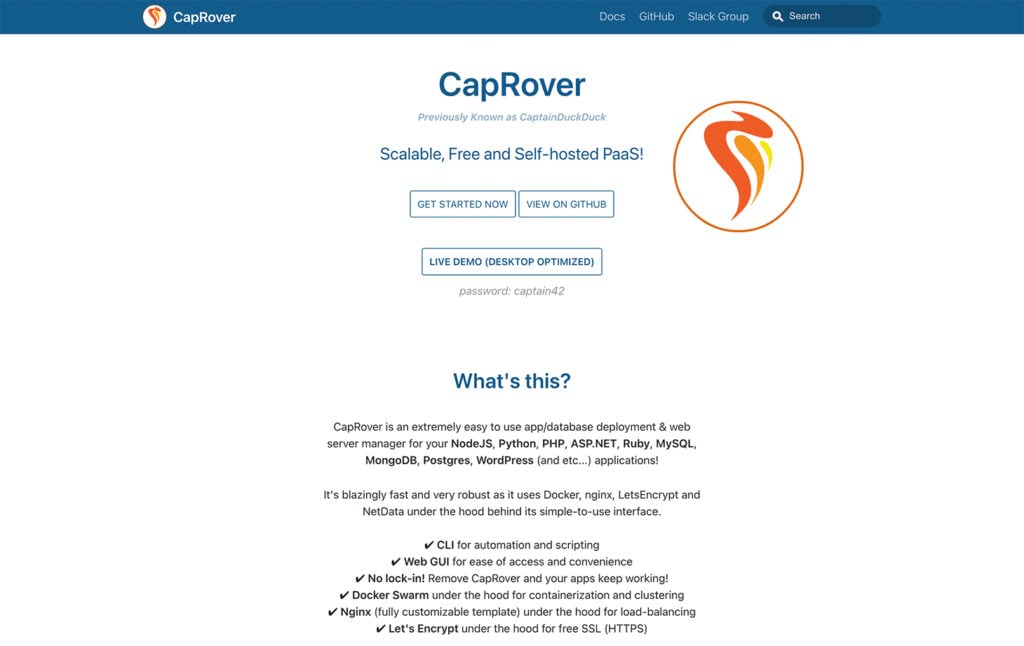
CapRover is a self-hosted app deployment platform that runs on Docker and comes with a simple web interface.
It lets you deploy and manage apps with Heroku-like simplicity, offering one-click installs, auto-scaling, and no monthly fees.
Best for: Quickly deploying and managing apps and databases on your own server. Ideal for developers who want a simpler alternative to Heroku without ongoing platform fees.
Pricing: Free to use.
Key features:
- Custom domain configuration made easy. Assign and manage domains or subdomains for each app directly within the CapRover dashboard.
- Built-in log viewer. Check logs for each deployed app in real time to help with troubleshooting and monitoring.
- Automatic nginx reverse proxy setup. Routes traffic to your apps without requiring you to manually configure Nginx.
- Lightweight install process. Set up CapRover on a fresh server using a single terminal command – no extra software required beyond Docker.
- Runs stateless apps with scaling support. Easily scale apps across containers on a single server while maintaining Docker-based isolation.
Pros:
- Installable on any VPS or cloud server with Docker installed.
- GUI and CLI for managing apps, domains, and services.
- One-click deployment for apps like WordPress, MongoDB, etc.
- Built-in SSL (via Let’s Encrypt), monitoring, and resource stats.
- Supports multi-app scaling through Docker Swarm.
Cons:
- Requires server setup and basic Docker knowledge.
- Access control features are limited.
- Not suitable for enterprise-level multi-cluster deployments.
8. AWS Elastic Beanstalk
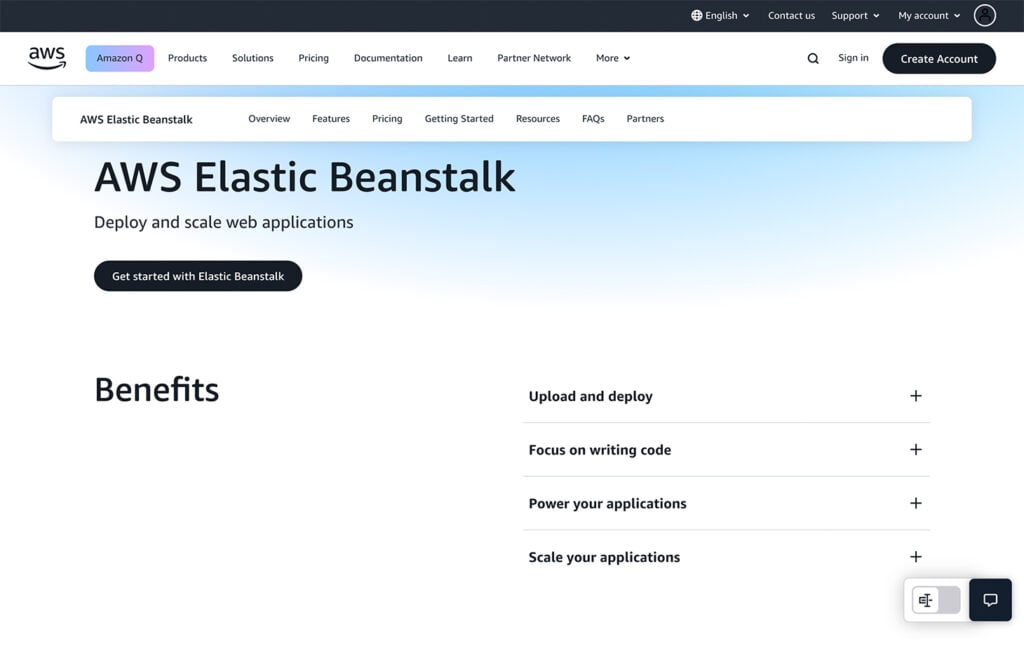
Elastic Beanstalk is a fully managed PaaS from Amazon Web Services (AWS) that simplifies deploying and scaling applications by handling provisioning, load balancing, and health checks.
It still allows direct access and customization of AWS services. With Git-based workflows via the EB CLI, it delivers a Heroku-like experience for AWS users.
Best for: Deploying scalable web applications on AWS with minimal setup, while retaining access to AWS services and customization options.
Pricing: Elastic Beanstalk is free to use as a service. You only pay for the underlying AWS resources your app consumes, such as EC2 or S3. A free tier is available, which covers limited usage for new accounts.
Key features:
- Managed environment lifecycle. Easily set up and manage multiple environments with isolated configurations and resources.
- Built-in application versioning. Upload, store, and roll back to previous application versions directly within the Elastic Beanstalk environment.
- Platform-managed updates. Keep your environment secure and current with automatic platform updates managed by AWS.
- Log management through console or CLI. View, download, and stream logs in real-time to diagnose and resolve issues quickly.
- AWS ecosystem integration. Works natively with services like CodePipeline, CloudFormation, CloudWatch, and RDS for a more complete deployment workflow.
Pros:
- Supports multiple languages and development stacks.
- Auto-provisions EC2 instances, load balancers, and storage.
- Integrated monitoring, logging, and health checks.
- Supports rolling and immutable updates designed to minimize or avoid downtime.
- Scales vertically and horizontally.
Cons:
- No support for non-AWS infrastructure.
- Customization requires digging into EC2, IAM, and networking.
- Can be overkill for small apps or solo developers.
9. Docker Swarm
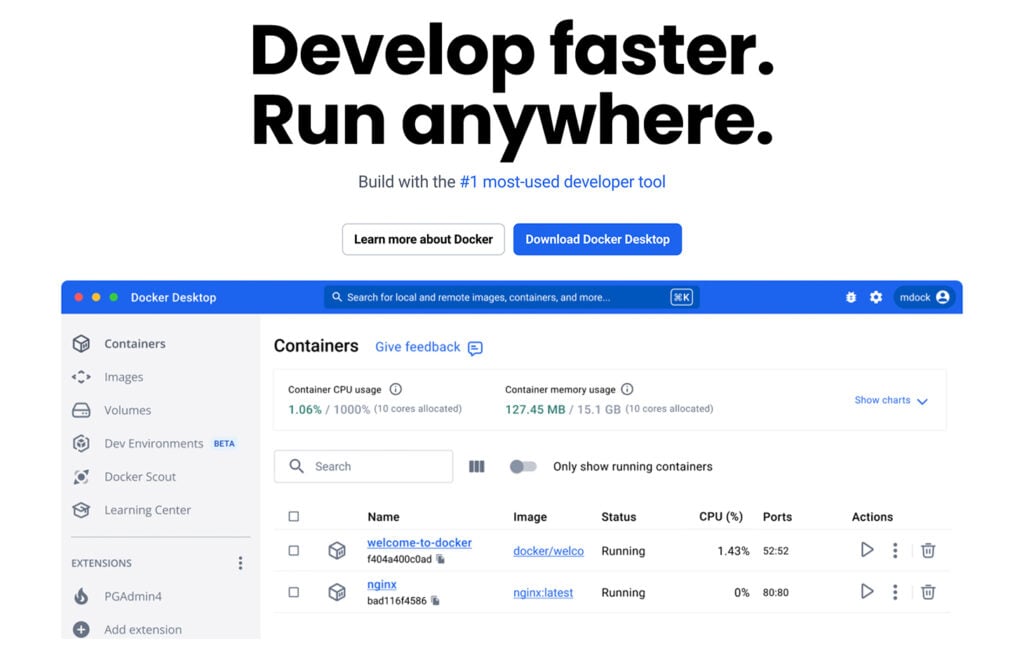
Docker Swarm is Docker’s native container orchestration tool, designed to manage and scale containers across multiple servers.
Docker itself is a platform that lets developers package applications into lightweight, portable containers that run consistently across environments.
Swarm extends this by enabling teams to deploy and manage those containers across multiple machines as a unified cluster.
Docker Swarm focuses solely on orchestration. It does not include a user interface, Git-based deployment, or built-in app templates. It’s the successor to the now-deprecated “Classic Swarm” and remains part of the Docker Engine.
Best for: Running containerized applications across multiple servers using Docker, especially for teams who want basic orchestration without the complexity of Kubernetes.
Pricing: Free to use as part of the Docker Engine
Key features:
- Declarative service model. Define the desired state of services, and Swarm maintains that state automatically.
- Integrated cluster management. Manage clusters natively using the same Docker CLI and API. No separate toolchain required.
- Built-in load balancing. Distributes incoming requests across healthy containers within a service.
- Rolling service updates. Update services one task at a time to minimize downtime, with built-in rollback if needed.
- TLS-based encryption. Secures communication between nodes with automatic certificate rotation.
Pros:
- Built directly into Docker, no extra install needed.
- Simplifies multi-node deployment and service discovery.
- CLI-based orchestration with scaling and rolling updates.
- Secure networking and secret management.
- Lightweight and faster to set up than full-scale infrastructure tools.
Cons:
- No GUI or dashboard by default.
- No auto-scaling or advanced policies.
- Community and tooling smaller than Kubernetes.
- Lacks Heroku-style features like Git-based deploys, add-ons, and buildpacks.
Factors to consider when choosing a Heroku alternative
The following factors can help you find a suitable alternative to Heroku.
- Hosting and control preferences. Decide whether you want a fully managed platform or prefer the control of self-hosting your own server.
- Pricing structure. Look for a pricing model that fits your budget and usage patterns – some platforms offer pay-as-you-go billing while others charge flat monthly fees or require self-managed infrastructure.
- Supported languages and frameworks. Make sure the platform supports your programming language and deployment method, whether you’re using Node.js, Python, Docker, or buildpacks.
- Ease of deployment. Choose a service that fits your workflow, whether you want one-click Git deploys, Docker-based deployments, or infrastructure-as-code support.
- Customization, scalability, and built-in tools. If you need more control over memory, CPU, or networking, pick a platform that lets you customize resources. Some tools also include extras like database provisioning or cron jobs.
- Monitoring, logs, and security. Real-time dashboards, error alerts, HTTPS, and domain or network controls can help maintain app health and performance.
- Team collaboration and support. If you’re working with others, role-based access and active support channels can ease troubleshooting and project management.
Key takeaways
While Heroku made app deployment simple, today’s landscape offers numerous alternatives tailored to different needs. Whether you’re looking for more control, scalability, or ease of use, there’s a solution that fits your requirements.
Here’s a quick guide to help you make the right choice:
- For self-hosted control: Platforms like Coolify, CapRover, and Dokku are ideal for developers who want complete control over their infrastructure. Pair them with VPS hosting, such as Hostinger’s plans, to manage your app with SSH access, IPv6 support, and snapshot backups for seamless setup and management.
- For managed PaaS convenience: If you prefer a fully managed solution, Render, Railway, and Fly.io offer hassle-free Git-based deployments, autoscaling, and user-friendly dashboards with minimal server management.
- For AWS users: Elastic Beanstalk offers a robust integration with AWS, automating deployment while giving you access to the full AWS ecosystem for more advanced configurations.
The best platform for you depends on your specific needs — whether you prioritize control, simplicity, or integration with existing tools.
Choosing the right platform now can streamline your workflow and set your project up for long-term success.
Heroku alternatives FAQ
What are the best Heroku alternatives?
Top Heroku alternatives include Coolify, Render, Railway, Fly.io, CapRover, and Dokku. These platforms offer similar ease of deployment but with added features, better performance, and lower costs.
What features should I look for in Heroku alternatives?
Look for Git-based deploys, Docker support, auto-scaling, database integrations, and real-time logs. Also check for transparent pricing, custom resource control, and easy setup. Teams may need role-based permissions, collaboration tools, and private networking for security and flexibility.
Are there free alternatives to Heroku?
Yes. Free Heroku alternatives include Coolify, CapRover, and Dokku. They’re open source and cost nothing beyond your server. Managed platforms like Render and Railway also offer limited free tiers.
All of the tutorial content on this website is subject to Hostinger's rigorous editorial standards and values.

